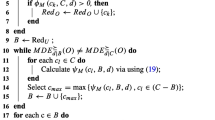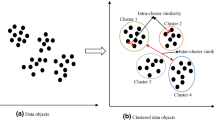Abstract
The Eclat algorithm is one of the most widely used frequent itemset mining methods. However, the inefficiency for calculating the intersection of itemsets makes it a time-consuming method, especially when the dataset has a large number of transactions. In this work, for the purpose of efficiency improvement, we proposed an approximate Eclat algorithm named HashEclat based on MinHash, which could quickly estimate the size of the intersection set, and adjust the parameters k, E and minSup to consider the tradeoff between accuracy of the mining results and execution time. The parameter k is the top-k parameter of one-permutation MinHash algorithm; the parameter E is the estimate error of one intersection size; the parameter minSup is the minimum support threshold. In many real situations, an approximate result with faster speed maybe more useful than ‘exact’ result. The theoretical analysis and experiment results that we present demonstrate that the proposed algorithm can output almost all of the frequent itemset with faster speed and less memory space.



































Similar content being viewed by others
References
Han J, Kamber M (2006) Data mining: concepts and techniques. Data Min Concepts Models Methods Algorithms Second Ed 5(4): 1–18
Agrawal R, Srikant R (1994) Fast algorithms for mining association rules. In: Proceedings 20th international conference very large data bases, VLDB vol, pp 487–499
Han J, Pei J, Yin Y (2000) Mining frequent patterns without candidate generation. In: ACM sigmod record, pp 1–12
Zaki MJ (2000) Scalable algorithms for association mining. IEEE Trans Knowl Data Eng 12(3):372–390
Heaton J (2016) Comparing dataset characteristics that favor the Apriori, Eclat or FP-growth frequent itemset mining algorithms. In: Southeast con, pp 1–7
Preiss PM, Ma R, Tai ME, Lukin A, Rispoli M, Zupancic P, Greiner M (2015) Strongly correlated quantum walks in optical lattices. Science 347(6227):1229–1233
Zaki MJ, Gouda K (2003) Fast vertical mining using diffsets. In: ACM SIGKDD international conference on knowledge discovery and data mining, pp 326–335
Ma Z, Yang J, Zhang T, Liu F (2016) An improved eclat algorithm for mining association rules based on increased search strategy. Int J Database Theory Appl 9(5):251–266
Xiong ZY, Chen PE, Zhang YF (2010) Improvement of eclat algorithm for association rules based on hash boolean matrix. Appl Res Comput 27(4):1323–1325
Cohen H, Porat E (2010) Fast set intersection and two-patterns matching. Theor Comput Sci 411(40–42):3795–3800
Wang X, Wang R, Xu C (2018) Discovering the relationship between generalization and uncertainty by incorporating complexity of classification. IEEE Trans Cybern 48(2):703–715
Wang R, Wang X, Kwong S et al (2017) Incorporating diversity and informativeness in multiple-instance active learning. IEEEE Trans Fuzzy Syst 25(6):1460–1475
Cohen E, Kaplan H (2013) What you can do with coordinated samples. Lect Notes Comput Sci 8096:452–467
Cohen E, Kaplan H, Sen S (2009) Coordinated weighted sampling for estimating aggregates over multiple weight assignments. Proc VLDB Endow 2(1):646–657
Teschner M, Heidelberger B, Müller M, Pomerantes D, Gross MH (2003) Optimized spatial hashing for collision detection of deformable objects. In: Vmv, pp 47–54
Broder AZ, Charikar M, Frieze AM, Mitzenmacher M (2000) Min-wise independent permutations. J Comput Syst Sci 60(3):630–659
Cohen E, Datar M, Fujiwara S, Gionis A, Indyk P, Motwani R et al (2001) Finding interesting associations without support pruning. IEEE Trans Knowl Data Eng 13(1):64–78
Pagh R, Stöckel M, Woodruff DP (2014) Is min-wise hashing optimal for summarizing set intersection?. In: Proceedings of the 33rd ACM SIGMOD-SIGACT-SIGART symposium on principles of database systems, pp 109–120
Goethals B (2002) Survey on frequent pattern mining. Univ Helsinki 63(14):47–52
Aggarwal CC, Han J (eds) (2014) Frequent pattern mining. Springer, Berlin, pp 19–23
Wang X, Zhang T, Wang R (2017) Non-iterative deep learning: incorporating restricted boltzmann machine into multilayer random weight neural networks. In: IEEE transactions on systems, man, and cybernetics: systems, IEEE early access articles, p 99
Xun Y, Zhang J, Qin X, Zhao X (2017) Fidoop-dp: data partitioning in frequent itemset mining on hadoop clusters. In: IEEE transactions on parallel and distributed systems, vol 99, pp 77–84
Broder AZ, Charikar M, Frieze AM, Mitzenmacher M (1998) Min-wise independent permutations (extended abstract). In: Stoc’98 Proceedings of the Thirtieth annual acm symposium on theory of computing, vol 60, no 3, pp 327–336
Broder AZ (1997) On the resemblance and containment of documents. In: Proceedings of compression and complexity of sequences, pp 21–29
Leskovec J, Rajaraman A, Ullman JD (2014) Mining of massive datasets. Cambridge University Press, Cambridge, pp 7–15
Wang X, Xing HJ, Li Y et al (2015) A study on relationship between generalization abilities and fuzziness of base classifiers in ensemble learning. IEEE Trans Fuzzy Syst 23(5):1638–1654
Szmit R (2013) Locality sensitive hashing for similarity search using MapReduce on large scale data. In: Language processing and intelligent information systems, pp 171–178
Chum O, Philbin J, Zisserman A (2008) Near duplicate image detection: min-Hash and tf-idf weighting. In: BMVC, pp 812–815
Wang H, Cao J, Shu L, Rafiei D (2013) Locality sensitive hashing revisited: filling the gap between theory and algorithm analysis. In Proceedings of the 22nd ACM international conference on information and knowledge management, pp 1969–1978
Li P, Owen A, Zhang CH (2012) One permutation hashing for efficient search and learning. arXiv preprint arXiv, pp 1208–1259
Li P, Shrivastava A, Moore J, König AC (2011) B-bit minwise hashing for large-scale learning. Comput Sci 54(8):101–109
Wang X, Wang R, Feng H-M, Wang H (2014) A new approach to classifier fusion based on upper integral. IEEE Trans Cybern 44(5):620–635
Li P, Gui W (2010) b-Bit minwise hashing for estimating three-way similarities. In: International conference on neural information processing systems, pp 1387–1395
Frequent Itemset Mining Dataset Repository, Available at: http://fimi.ua.ac.be/data. Accessed 18 Dec 2018
Huang H, Xu H, Wang X, Silamu W (2015) Maximum f1-score discriminative training criterion for automatic mispronunciation detection. IEEE/ACM Trans Audio Speech Lang Process 23(4):787–797
Wang X, He Y-L, Dabby D (2014) Non-naive bayesian classifiers for classification problems with continuous attributes. IEEE Trans Cybern 44(1):21–39
Acknowledgements
This study was supported by the Foundation Item: Shenzhen Research Council (no. JSGG20170822160842949, JCYJ20170307151518535).
Author information
Authors and Affiliations
Corresponding author
Additional information
Publisher’s Note
Springer Nature remains neutral with regard to jurisdictional claims in published maps and institutional affiliations.
Rights and permissions
About this article
Cite this article
Zhang, C., Tian, P., Zhang, X. et al. HashEclat: an efficient frequent itemset algorithm. Int. J. Mach. Learn. & Cyber. 10, 3003–3016 (2019). https://doi.org/10.1007/s13042-018-00918-x
Received:
Accepted:
Published:
Issue Date:
DOI: https://doi.org/10.1007/s13042-018-00918-x




